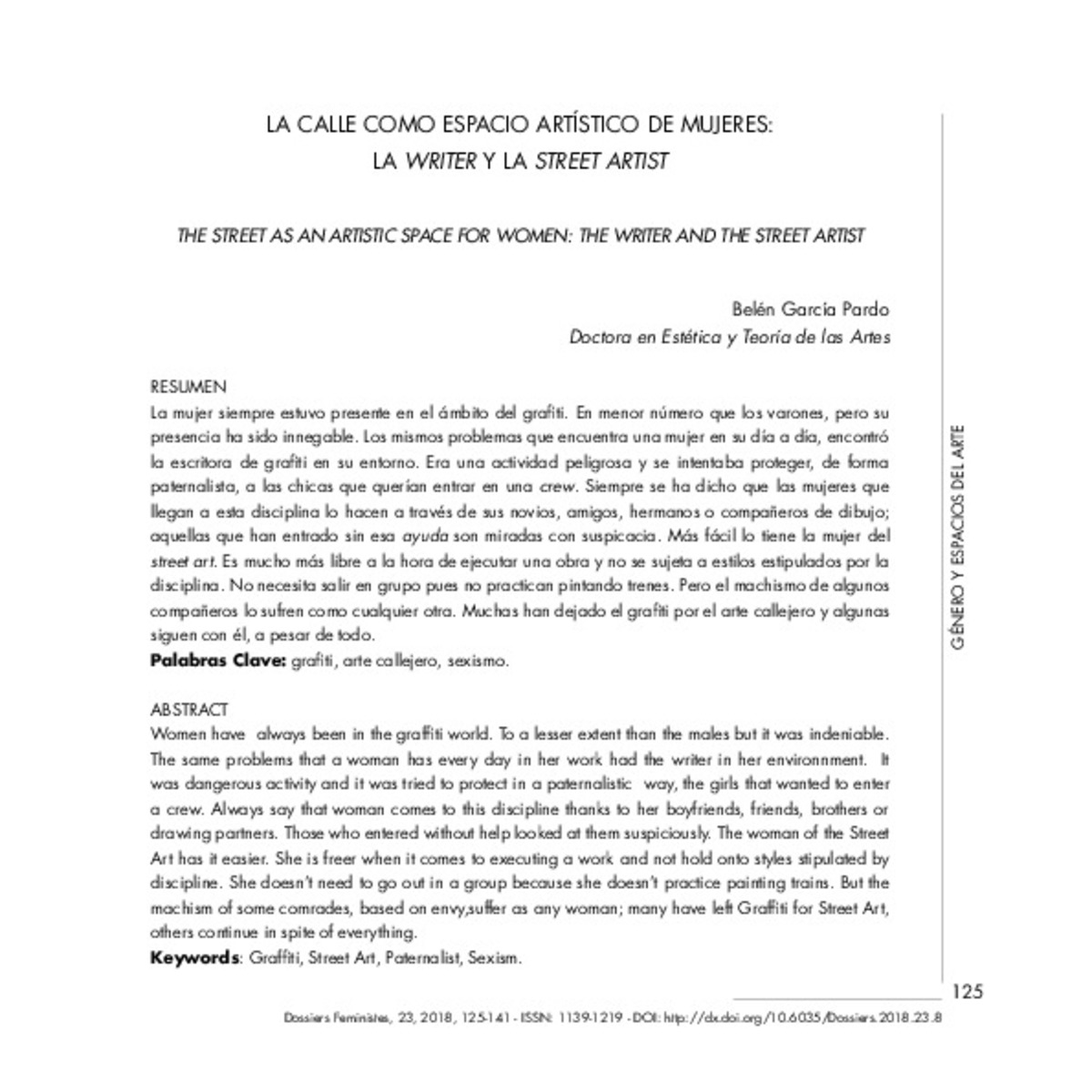Mostrar el registro sencillo del ítem
La calle como espacio artístico de mujeres: la writer y la street artista
| dc.contributor.author | García Pardo, Belén | |
| dc.date.accessioned | 2018-09-26T07:41:33Z | |
| dc.date.available | 2018-09-26T07:41:33Z | |
| dc.date.issued | 2018 | |
| dc.identifier.citation | GARCÍA PARDO, Belén. La calle como espacio artístico de mujeres: la writer y la street artista. Dossiers feministes, 2018, no 23, p. 125-141. | ca_CA |
| dc.identifier.issn | 1139-1219 | |
| dc.identifier.issn | 2340-4930 | |
| dc.identifier.uri | http://hdl.handle.net/10234/176266 | |
| dc.description.abstract | Women have always been in the graffiti world. To a lesser extent than the males but it was indeniable. The same problems that a woman has every day in her work had the writer in her environnment. It was dangerous activity and it was tried to protect in a paternalistic way, the girls that wanted to enter a crew. Always say that woman comes to this discipline thanks to her boyfriends, friends, brothers or drawing partners. Those who entered without help looked at them suspiciously. The woman of the Street Art has it easier. She is freer when it comes to executing a work and not hold onto styles stipulated by discipline. She doesn’t need to go out in a group because she doesn’t practice painting trains. But the machism of some comrades, based on envy,suffer as any woman; many have left Graffiti for Street Art, others continue in spite of everything. | ca_CA |
| dc.description.abstract | La mujer siempre estuvo presente en el ámbito del grafiti. En menor número que los varones, pero su presencia ha sido innegable. Los mismos problemas que encuentra una mujer en su día a día, encontró la escritora de grafiti en su entorno. Era una actividad peligrosa y se intentaba proteger, de forma paternalista, a las chicas que querían entrar en una crew. Siempre se ha dicho que las mujeres que llegan a esta disciplina lo hacen a través de sus novios, amigos, hermanos o compañeros de dibujo; aquellas que han entrado sin esa ayuda son miradas con suspicacia. Más fácil lo tiene la mujer del street art. Es mucho más libre a la hora de ejecutar una obra y no se sujeta a estilos estipulados por la disciplina. No necesita salir en grupo pues no practican pintando trenes. Pero el machismo de algunos compañeros lo sufren como cualquier mujer. Muchas han dejado el grafiti por el arte callejero, otras siguen con él a pesar de todo. | ca_CA |
| dc.format.extent | 17 p. | ca_CA |
| dc.format.mimetype | application/pdf | ca_CA |
| dc.language.iso | spa | ca_CA |
| dc.publisher | Universitat Jaume I. Institut Universitari d'Estudis Feministes i de Gènere | ca_CA |
| dc.relation.isPartOf | Dossiers feministes, 2018, no. 23 | ca_CA |
| dc.rights.uri | http://rightsstatements.org/vocab/CNE/1.0/ | * |
| dc.subject | grafiti | ca_CA |
| dc.subject | arte callejero | ca_CA |
| dc.subject | sexismo | ca_CA |
| dc.subject | graffiti | ca_CA |
| dc.subject | street art | ca_CA |
| dc.subject | paternalist | ca_CA |
| dc.subject | sexism | ca_CA |
| dc.title | La calle como espacio artístico de mujeres: la writer y la street artista | ca_CA |
| dc.title.alternative | The street as an artistic space for women: The writer and the street artist | ca_CA |
| dc.type | info:eu-repo/semantics/article | ca_CA |
| dc.identifier.doi | http://dx.doi.org/10.6035/Dossiers.2018.23.8 | |
| dc.rights.accessRights | info:eu-repo/semantics/openAccess | ca_CA |
| dc.relation.publisherVersion | http://www.e-revistes.uji.es/index.php/dossiers/article/view/3382 | ca_CA |







